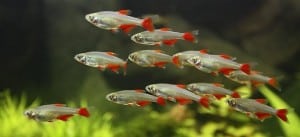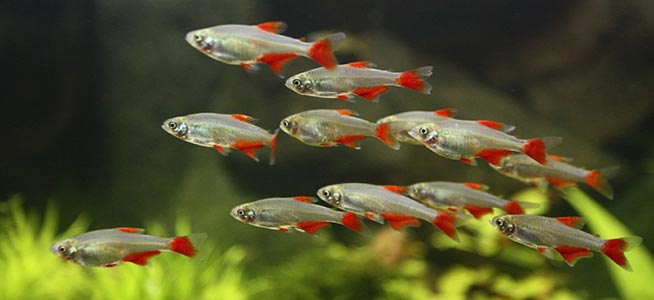
Common name: Bloodfin Tetra
Scientific name: Aphyocharax Anisitsi
Average Adult Fish Size: 2 inches / 6 cm
Place of Origin: Río Paraná basin in South America.
Typical Tank setup: Well planted typical community aquarium with some rocks and driftwood/bogwood.
Recommended Minimum Aquarium Capacity: 15 gallon / 60 litre
Compatibility: It is very common to keep Bloodfin Tetras with Corydoras as companions, as they are both quite peaceful and other tank mates like Guppies, other Tetras, Rasboras, Mollies & Platies
Temperature: 64 – 82 Deg F / 18 – 28 Deg C
Water chemistry: pH 6.0 – 8.0
Feeding: Wild Bloodfin Tetras are omnivores that feed chiefly on plants, worms and small crustaceans. They should be kept on a varied diet in the aquarium. You can give them small live food such as brine shrimp, but they will also accept frozen and dry foods
Sexing: Male Bloodfin Tetras are a bit more colourful than the females and feature a small hook on the anal fin. The female have a plumper body shape.
Breeding: Bloodfin Tetras are prolific breeders and will often spawn spontaneously without any coaxing from the aquarist. Their natural instinct is to release the eggs among broad-leaved plants, but if no such plants are present they will sometimes release the eggs over aquarium glass. The eggs are not adhesive. During the spawning, the Bloodfin Tetra will leap out of the water and the eggs will drop down. One female will usually produce between 300 and 500 eggs during each spawning.
Additional Information: The Bloodfin tetra is a shoaling fish and you should therefore keep at least five specimens together. When a Bloodfin tetra is kept alone, or in a very small group, it will usually become very shy and spend most of its time hiding. In a shoal, they are much more bold and active and spend a lot of time out in the open. A Bloodfin tetra can sometimes leave the group and explore the aquarium on its own, but it will always return to the safety of the group as soon as it feels threatened.


Related Posts
Croaking Gourami – Trichopsis vittatus
Paradise Fish – Macropodus opercularis
Schubert’s Barb – Barbus Semifasciolatus